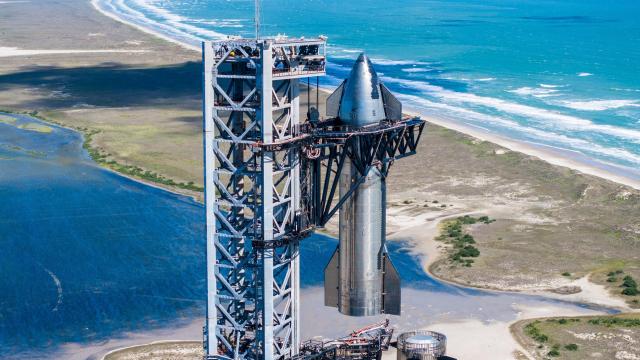SpaceX is preparing to launch its Starship rocket for the second time, aiming for mid-November for another flight test of its launch vehicle after the first one didn’t go so well.
It’s been over six months since Starship lifted off for the very first time, a problematic debut that has kept the rocket grounded since then. But now SpaceX claims that the second test flight of its megarocket could launch as early as mid-November, “pending regulatory approval,” the company wrote on X. Sources also told Spaceflight Now that Starship’s launch could take place as early as November 13.
Elon Musk’s private space venture has been eager to see Starship take to the skies once again. SpaceX has previously claimed that its rocket has been ready for its second test flight for over a month. The company, however, can’t fly Starship without the green light from Federal Aviation Administration (FAA).
Last week, the FAA completed its safety review of Starship but the administration is still waiting on the conclusion of an environmental review by the U.S. Fish and Wildlife Service before it can grant SpaceX its launch license. The review began on October 19, in collaboration with the FAA, to look into the potential environmental impacts and threats to endangered species in the sensitive Boca Chica region as a consequence of recent upgrades at SpaceX’s south Texas Starbase, particularly the newly installed water deluge system.
At the time, it was stated that the assessment would take anywhere from 30 to 135 days to complete. The USFWS says it likely won’t need the entire duration to perform the review, but assuming an earliest case scenario of 30 days, that still takes us to November 18. Consequently, a November 13 launch date doesn’t seem entirely realistic, with all due respect to Spaceflight Now’s unidentified sources.
Starship embarked on its initial flight on April 20, but after entering into a catastrophic tumble about four minutes into the mission, ground controllers were forced to issue a self-destruct command. The rocket, troublingly, did not respond to the command right away, leading to a dangerous delay over the Gulf of Mexico. At the Boca Chica launch site in south Texas, the big blast off resulted in several serious issues, including major damage to the launch mount, the igniting of several wildfires, disruption to local wildlife, and the widespread scattering of debris across hundreds of acres.
The FAA closed its investigation into Starship’s botched flight in September, handing SpaceX a list of 63 corrective measures to secure its next Starship launch license. The measures included a redesign of the vehicle’s hardware to prevent leaks and fires, and a modification of the launch pad to boost its resilience. SpaceX has made some changes to the launch pad since Starship’s first launch, including steel reinforcements beneath the launch mount and a new water deluge system to quell the power of Starship’s 33 Raptor engines.
“Starship’s first flight test provided numerous lessons learned that directly contributed to several upgrades to both the vehicle and ground infrastructure to improve the probability of success on future flights,” SpaceX wrote on its website. “The second flight test will debut a hot-stage separation system and a new electronic Thrust Vector Control (TVC) system for Super Heavy Raptor engines, in addition to reinforcements to the pad foundation and a water-cooled steel flame deflector, among many other enhancements.”
There is a lot riding on Starship’s ability to ace its test flight this time around. SpaceX is under a $US2.89 billion contract to use a lunar lander version of its Starship rocket in landing humans on the Moon by late 2025 as part of the space agency’s Artemis 3 mission, and then again for Artemis 4 in 2028, under a separate $US1.15 billion contract signed last year. SpaceX also needs its megarocket to carry the upgraded version of its Starlink satellites to orbit, helping the company meet growing demand for its internet service.
